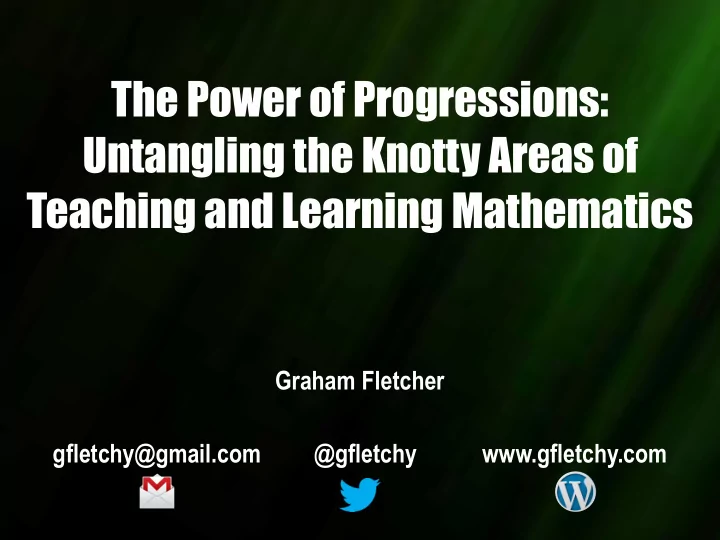

The Power of Progressions: Untangling the Knotty Areas of Teaching and Learning Mathematics Graham Fletcher gfletchy@gmail.com @gfletchy www.gfletchy.com
Procedural Conceptual Fluency Understanding Application http://www.corestandards.org/other-resources/key-shifts-in-mathematics/
Procedural Fluency
Procedural Conceptual Fluency Understanding Application http://www.corestandards.org/other-resources/key-shifts-in-mathematics/
Demetrius has 17 Skittles which is 12 fewer than Alicia. How many Skittles does Alicia have?
Demetrius has 17 Skittles which is 12 fewer than Alicia. How many Skittles does Alicia have?
Demetrius has 17 Skittles which is 12 fewer than Alicia. How many Skittles does Alicia have?
Demetrius has 17 Skittles which is 12 fewer than Alicia. How many Skittles does Alicia have?
Demetrius has 17 Skittles which is 12 fewer than Alicia. How many Skittles does Alicia have?
17 12 fewer
17 12
17 12 W T F ?
17 12 W T F ? hat’s he ive
Current Research
65%
“65% of children entering primary school today will ultimately end up working in completely new job types that don’t yet exist.” http://reports.weforum.org/future-of-jobs-2016/chapter-1-the-future-of-jobs-and-skills/
“Early mathematics competency predicts later reading achievement better than early literacy skills.” A. Szekely. Unlocking Young Children’s Potential: Governors’ Role in Strengthening Early Mathematics Learning (Washington, D.C.: National Governors Association Center for Best Practices, October 28, 2014).
You little plucker! John SanGovanni, NCTM ‘16
number You little plucker! John SanGovanni, NCTM ‘16
?
The Big Reveal
Graham had some Skittles. He had 19 yellow, 15 orange, 19 green, 17 purple, and 21 red. How many Skittles did Graham have?
3-Act Tasks Act 1: • Real world problem or scenario presented • What do you notice? What do you wonder? • Make estimates Act 2: • Identify missing variables and missing variables to solve • Define solution path using variables Act 3: • Solve and interpret results of the solution • Validate answer
Most asked questions: • How often should we use 3-Act Tasks? • When should we use 3-Act tasks? How do they fit into the scope of a unit? • How long does one task usually take? • What if we don’t have the time?
5 The practices are: 1. Anticipating student responses to challenging mathematical tasks; 2. Monitoring students’ work on and engagement with the tasks; 3. Selecting particular students to present their mathematical work; 4. Sequencing the student responses that will be displayed in a specific order and; 5. C onnecting different students’ responses and connecting the responses to key mathematical ideas. MTMS: Vol. 14, No. 9, May 2009-5 Practices for Orchestrating Productive Mathematics Discussions
Identify and name the strategy used, then place the student work in order in terms of efficiency (least to greatest)
Identify and name the strategy used, then place the student work in order in terms of efficiency (least to greatest)
19+15+19+17+21
1-counting all 1-counting all
2-counting all 1-counting all with skip counting 1-counting all
2-counting all 1-counting all with skip counting 1-counting all 3-making tens from ones
2-counting all 1-counting all 4-making tens with skip from ones counting 1-counting all 3-making tens from ones
5-Place value 2-counting all 1-counting all 4-making tens partitioning with skip from ones counting 1-counting all 3-making tens from ones
5-Place value 2-counting all 1-counting all 4-making tens partitioning with skip from ones counting 1-counting all 6-Partial Sums 3-making tens from ones
5-Place value 2-counting all 1-counting all 4-making tens partitioning with skip from ones counting 7-Landmark Numbers 1-counting all 6-Partial Sums 3-making tens from ones
5-Place value 2-counting all 1-counting all 4-making tens partitioning with skip from ones counting 7-Landmark Numbers 1-counting all 6-Partial Sums 3-making tens from ones
5-Place value 2-counting all 1-counting all 4-making tens partitioning with skip from ones counting 7-Landmark Numbers 1-counting all 6-Partial Sums 3-making tens from ones
3-Act Tasks 5 Practices Progressions
Using the digits 1-9 at most one time each, create 4 numbers that have a sum of 91. + + + = 91 You can use the 9 & 1 from the cards
Kindergarten?
Recommend
More recommend